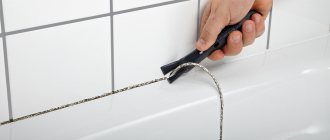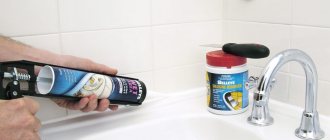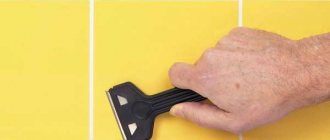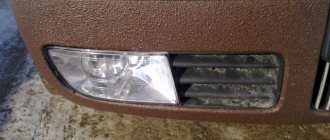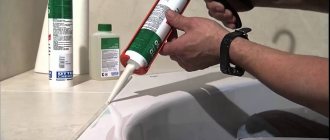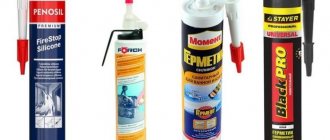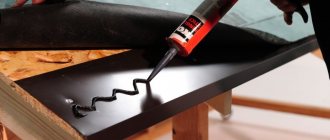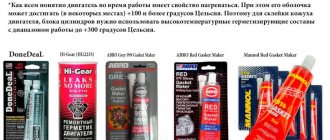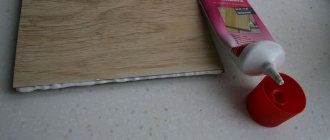Sealants are widely used for construction and repair work. These are modern materials with properties that allow you to perform work quickly and efficiently, and have high decorative and performance properties.
When performing work, sealant may come into contact with adjacent surfaces. Their subsequent cleaning is fraught with certain difficulties.
The need to clean surfaces also arises in cases of restoration of sealed seams or subsequent repairs.
How and with what to remove the sealant so as not to damage the surfaces, and the result is the most effective?
How to remove glass from sealant?
You should never tap the window glass when removing them from the frame. You just need to make slits where they are more tightly sealed with sealant, and the sealant does not come off. Using a thin blade of a knife or a stationery cutter, cut the silicone in a circle and the glass will be removed.
Interesting materials:
How to clean rust from a tank? How to remove label glue from a jar? How to clean a washing machine drum with citric acid? How to clean the drum? How to clean white laundry? How to clean white shoe soles? How to remove suede paint from white soles? How to clean grass from white soles? How to clean white dishes from plaque? How to clean white rubber sole?
Removal methods
Removing uncured sealant from the surface, as a rule, does not cause any particular difficulties. In most cases, this operation is carried out using rags, water (plain, salt or soap) or ordinary household solvents.
However, if the composition has already hardened, then the question of how to wipe off the sealant becomes especially relevant.
For this purpose, mechanical methods are used - using various tools, and chemical methods - using various solvents.
However, the best results are obtained by the combined use of these methods.
Mechanical
The mechanical method is usually used to remove old, already hardened sealant. This material has very good adhesion to substrates, is poorly soluble in most solvents, and it is often not possible to remove it in any other way.
Sometimes it is possible to remove the old sealant by prying one end of the seam and pulling it, tearing it away from the base.
The hardened sealant is also cut off from the surface with a knife, blade or other sharp tool. Its remnants are cleaned off using abrasives, for example, pumice, sandpaper.
When using this method, the hardness of the substrate must be taken into account. Adjacent areas of soft surfaces, such as acrylic bathtubs, can be easily damaged by harder material such as steel, sandpaper or other abrasives.
For this reason, the mechanical method is only suitable for fairly hard surfaces that do not produce scratches, or when its decorative appearance is not important.
Most sealants are much easier to remove if the joint is preheated with a hair dryer to a high temperature (about 400 degrees). In this case, the composition hardens, becomes brittle and can be easily cleaned with any suitable tool.
Chemicals
Various solvents or cleaners only affect certain components of the composition. In order to find out how to remove old sealant using a chemical method most effectively, you need to know its composition.
Most often, among construction silicone adhesives and sealants on sale, there are materials with an acid curing system (during application and polymerization, acetic acid vapors with a characteristic odor are released) - concentrated vinegar is suitable for removing them.
Materials with a neutral curing system (alcohol, amide, oxide) are wiped off with alcohol, white spirit, gasoline, acetone and other solvents.
There are specialized compositions for cleaning surfaces from hardened and uncured sealants. Their use will be the most effective, however, such compositions, as a rule, have a fairly high cost.
The most popular solvents and silicone removers are the following:
- Dowsil OS-2 (formerly Dow Corning OS-2)
- Dowsil DS-2025
- Penta-840
- Antisil
- CRC Gasket Remover
- Lugato Silicon Entferner
Some types of sealants (for example, polyurethane) cannot be wiped off chemically; they can only be removed mechanically.
Combined
And yet, how to remove the sealant if none of the above methods gives the desired effect?
In such cases, both methods are combined.
That is, you can, for example, soften the silicone with a solvent and then mechanically clean it from the surface.
Sometimes they do the opposite - they remove the sealant itself with tools, and then use a solvent to remove its remains and greasy traces.
In practice, the combined method is used most often.
Mechanical methods
If you are confident that the car was painted with high quality, it is permissible to resort to this option. The edge of a certain spot is initially and very carefully pryed off and then, gradually, the process of removing it occurs.
This option is rightfully considered one of the riskiest and time-consuming. If the contamination is located in a secluded place, you can experiment a little and try to remove it yourself. Provided that it is clearly visible, it is worth using less risky methods.
How to clean dried silicone sealant from a car body
Silicone sealant is a viscous mass based on low molecular weight silicone rubbers, which has an extremely high degree of adhesion (attraction). The composition penetrates deep into the pores of the surfaces being bonded and hardens at room temperature, so it requires careful application.
In everyday life, two types of one-component sealants are mainly used:
- acidic (“acetoxy”);
- neutral (containing alcohols – “alkoxy”, “methoxy”).
The easiest way to clean silicone sealant is when it has just been applied: just wipe the surface with a damp cotton rag (lint-free). How to clean mold from silicone sealant? If a little adhesive remains, it is removed with a solvent. Therefore, experienced craftsmen always keep a bowl of water nearby when working with glue.
But washing off dried sealant is a more difficult task.
Required Tools
Removing sealant is a simple procedure, but it requires a lot of patience and some skills in using simple tools and handling cleaning products.
Most often, the following tools and compounds are used to remove sealants:
- Soft, lint-free cloth
- Sponge
- Brush
- Pumice
- Metal wire washcloth
- Sandpaper
- Sharp thin knife (special corner, stationery)
- Blade
- Screwdriver or spatula
- Plastic scraper (plastic card)
- Water
- Soap
- Dishwashing liquid
- Special cleaning paste
- Table sodium salt
- Vinegar
- White spirit, gasoline, acetone
- Special solvents and cleaners
Chemicals
One of the most common and affordable options is kerosene and gasoline. At the same time, on car enthusiast forums you can often find information that it is possible to wipe off the sealant from a car only if the stain is fresh and absolutely no experimental actions have been carried out on it before.
If the sealant layer is thick, it will be impossible to remove it using the above components. Therefore, it is necessary to cut off at least half of the corresponding substance as carefully as possible and after that, by applying it to a piece of cloth, soften the affected area. Once the stain becomes pliable, it can be removed with a wooden stick without damaging the surface of the car.
In stores you can find special products used to remove sealant. At the same time, you should initially become familiar with what surfaces they can be used on and what concentration is selected for this. If we are talking about a significant degree of contamination, it will be possible to wipe off the sealant from the car only in two passes (the first time this product should remain on the contamination longer than the second).
Thus, when choosing the most suitable option, it is necessary to take into account both the characteristics of contamination and the nature of the surface.
We disassemble the headlight using sealant and put it back together with our own hands
Looking ahead, I would like to draw your attention to the fact that in order to successfully implement the work, you need to stock up not only with tools, but also with time. There is absolutely no need to rush in this process. It is also worth considering the fact that car headlights are divided into:
- collapsible - glued with a soft sealant;
- conditionally not collapsible - a hard sealant is used, which becomes hard after drying. In this case, the process of disassembling the headlight is the most labor-intensive and it is better to entrust it to experienced craftsmen.
In this article we will learn how to disassemble a headlight with sealant and put it back together with your own hands. Butyl cord was used to glue the glass and body together. It is classified as a soft sealant, and therefore our headlight is collapsible.
Butyl cord
Disassembling a headlight at home using improvised means is quite a risky task, since it is quite easy to damage the housing and/or glass.
Many people believe that having a hair dryer and some tools in the garage will save money on work. But what could go wrong? - you ask. As a result of inexperienced actions, the following may happen:
- damaged geometry of the headlight glass or headlight housing as a result of thermal effects;
- partial damage to the housing groove - most often happens if a screwdriver is used to remove the headlight glass;
- broken headlight glass - the process of removing the glass must be smooth, otherwise it will burst;
- leaky connection of the glass to the body - caused by insufficient heating of the new sealant or the glass is not tightly placed in the groove of the body.
How to remove headlight glass from sealant
After removing the headlight from the car, it must be cleaned of dust and dirt. Remove the brackets that hold the glass.
Bracket
Next, you need to warm up the headlight thoroughly. For this purpose, special ovens are used, in which heated air is constantly circulated and distributed throughout the chamber.
This process is not quick and lasts for 10-15 minutes. In this case, the temperature inside reaches 120-140 degrees Celsius. You need to be very careful not to overheat the plastic.
Furnace for disassembling headlights
The secret is to prevent hot air flows from directly affecting the headlight. In such heat chambers, the part is heated evenly along with the adhesive composition, and removing the headlight glass from the sealant, which becomes jelly-like, is practically easy.
Chemicals
You can use chemicals to dissolve the glue. Silicone-based glass sealant can be removed using Mellerud Silicon Entferner. If you have a question about how to remove glass sealant, try using this German-made product. It is used to remove fresh and hardened silicone. This gel is effectively used on acid-resistant surfaces. First, the layers of silicone are removed mechanically, then Mellerud is applied with a brush. Stubborn deposits of residual silicone are removed in 13 hours. Then the surface is cleaned with a spatula and wiped with a rag.
Instructions for use
How to install glass or headlights in a car using this sealant:
- Dismantle the desired structure, remove the remnants of the previous sealing substance.
- Remove the paper backing from the cord.
- Carefully, with light pressure, place the sealant into the groove for installing the glass.
- For even installation, lay the tape simultaneously in two opposite directions.
- Cut off any remaining excess sealant.
- Install the glass (headlight), carefully press it against the sealing material around the entire perimeter.
- Cover the gluing area with a decorative overlay.
Pieces of tape that do not fit into the groove can be subsequently used to seal small areas, glass joints, etc.
How to clean plastic and glass surfaces
How to wipe off silicone sealant if it gets on plastic, be it a shower stall, pipe or other similar surface? Oddly enough, it is easier to remove frozen sealant from plastic than from other surfaces, since silicone does not stick well to it. Can be cleaned with a suitable solvent. Apply the product to the contaminated area and after about an hour, wipe off the softened silicone with a cloth.
How to remove sealant from glass? For mechanical cleaning, a thin, sharp blade is suitable. True, such work will take a lot of time, and the likelihood of damaging the glass surface is high. A solvent is best. More precisely, white spirit or gasoline are cheap and accessible means.
The algorithm is the same: wet the contaminated areas, wait about an hour and wipe off the dirt.
